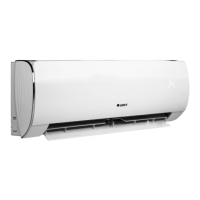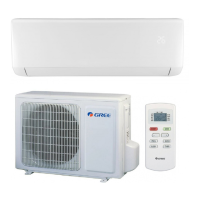
Do you have a question about the Gree GWH12AGC-K6DNA1A/I and is the answer not in the manual?
| Type | Split |
|---|---|
| Cooling Capacity | 3.5 kW |
| Power Supply | 220-240V, 50Hz |
| Power Consumption (Cooling) | 1100 W |
| Noise Level (Outdoor) | 50 dB |
| Refrigerant | R32 |
| Weight (Indoor Unit) | 8 kg |
| Weight (Outdoor Unit) | 30 kg |
| Energy Efficiency Ratio (EER) | 3.2 |
| Noise Level (Indoor) | 24 dB |
| Operating Temperature (Cooling) | 18°C to 43°C |
| Operating Temperature (Heating) | -7-24 °C |
Crucial safety guidelines for installing the air conditioner.
Critical safety advice for installing and relocating the unit.
Guidelines for choosing an appropriate installation site.
Procedures and requirements for electrical connections and grounding.
Steps for choosing location and installing the wall-mounting frame.
Creating a hole for pipes and guiding the outlet pipe.
Process of joining the indoor unit pipe with the bellmouth.
Wrapping pipes with insulating material and installing the drain hose.
Connecting the power connection wire to the indoor unit terminals.
Securing the wiring cover and binding pipes, power cord, and drain hose.
Mounting the indoor unit onto the wall-mounting frame.
How to clean the unit surface and its filters.
Routine checks before and after the operating season.
Identifying and troubleshooting common error codes.
Common issues and their initial checks and solutions.
Identification of parts like air inlet, filter, panel, and air outlet.
Explanation of icons shown on the unit's display.
Overview of the buttons on the remote controller.
Explanation of icons shown on the remote controller's display.
How to turn the unit on/off and select operating modes.
Details on operating the unit in different modes.
Adjusting fan speed and using the X-FAN function.
Using Turbo mode and adjusting temperature settings.
Controlling air direction swing and setting timers.
How to set and use different sleep modes for comfort.
Setting the current time on the remote controller.
Activating WiFi, health, and display light functions.
Using energy-saving and 8°C heating features.
Using child lock, switching temperature display, and auto clean.
Managing power limits and replacing remote batteries.
Verifying installation requirements and checking for malfunctions.
Steps for performing the initial test operation of the unit.
Guidelines for standard, minimum, and maximum pipe lengths.
Methods for calculating additional refrigerant and oil charges.
Steps for cutting, deburring, and expanding the pipe ends.
Specifies operating temperature limits for different models.
Safety checks for installations using flammable refrigerants.
Safety procedures for electrical components and repairs.
Essential checks for safety before and during work.
Guidelines for repairing components and checking cabling integrity.
Methods for detecting leaks and safely decommissioning the unit.
Detailed steps for safely recovering refrigerant and handling cylinders.












